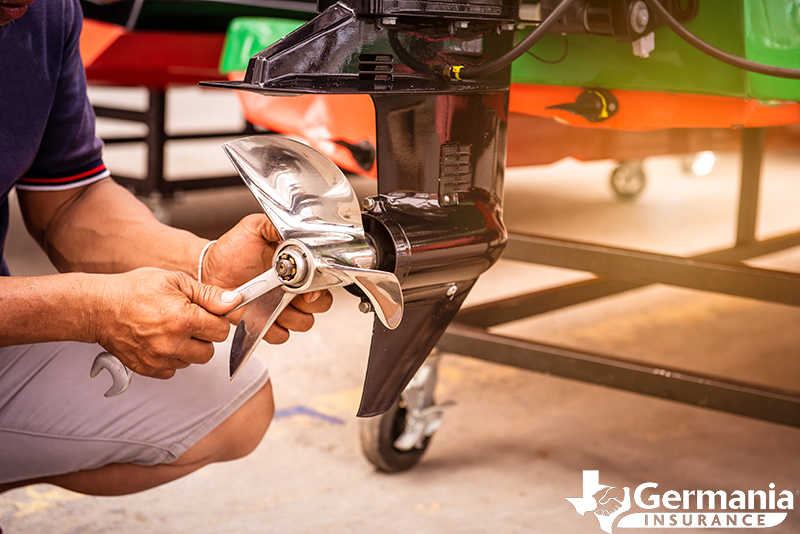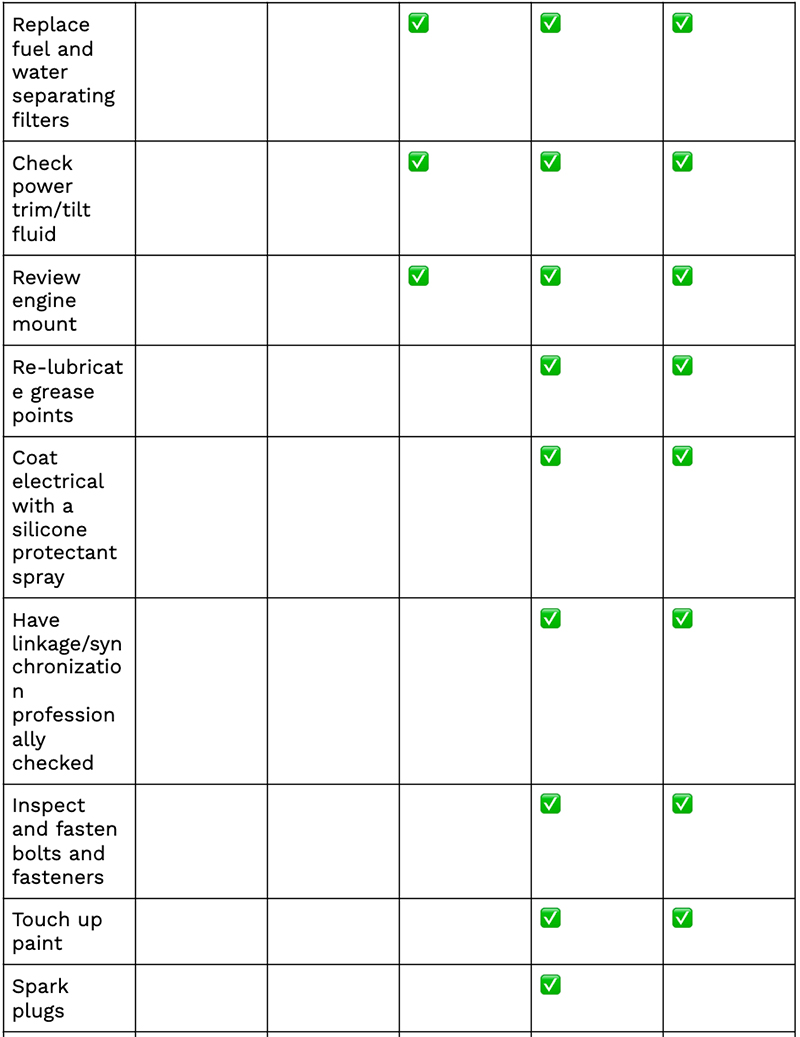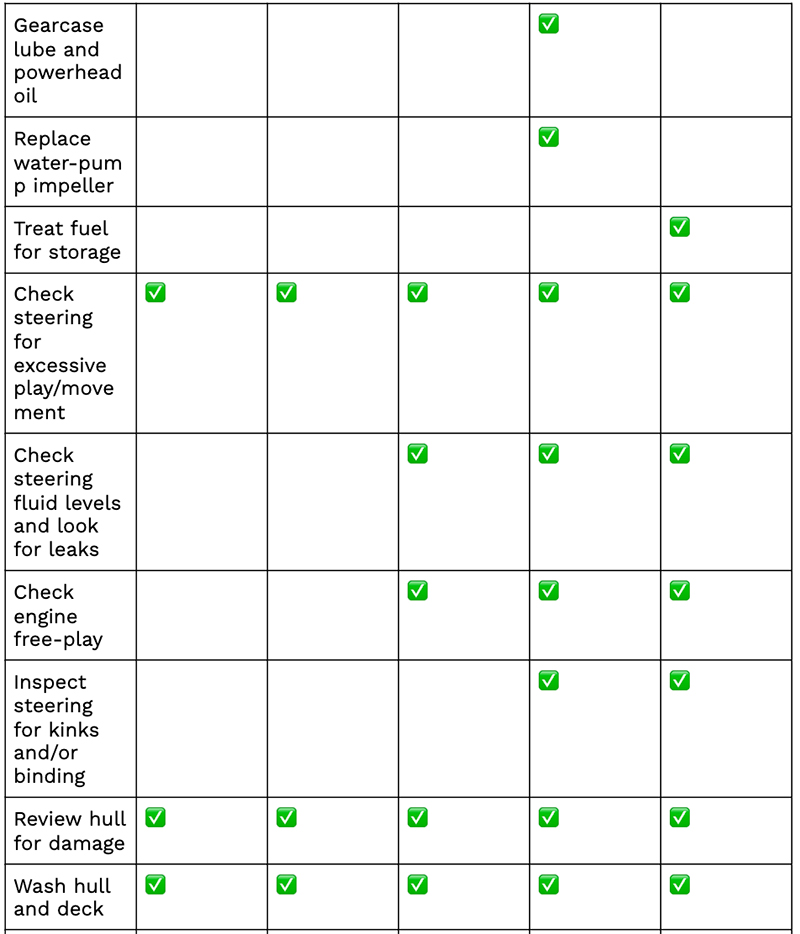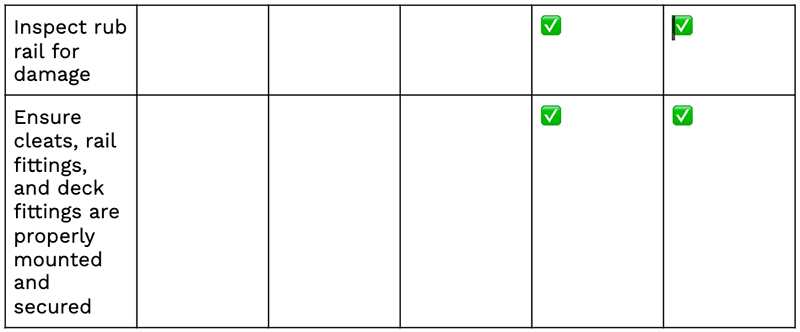Learn how to maintain your boat this summer with a schedule and checklist!

There’s no better place to be on a hot summer day than out on the open water! Whether you’re gone fishing, or just floating with friends and a full cooler, you always have weekends set when you own a boat.
Just about the only thing that could dampen a day out on the water is an unforeseen issue with your craft. Depending on the body of water that you’re in, being stranded out on a faulty vessel can be frustrating or dangerous.
That’s why it’s so important to keep up with boat maintenance, especially during the summer when you’re using your boat often.
Why boat maintenance is important
You might be surprised what percentage of all boating fatalities result from equipment/maintenance related factors. Avoidable maintenance oversights account for
8% of boating accidents and 4% of boat-related deaths. Rather than place yourself at extra risk, you can ensure your boat is water-ready by adhering to a strict maintenance schedule.
From it’s first time on the water for the season to winterizing your boat, you should have your own process for inspecting and maintaining your boat before and after every dip. A significant reason why maintenance issues aren’t too common is that most owners take immense pride in their vessels and treat boat maintenance as part of the hobby of boating.
Few boats aren’t deeply cherished by their owners. It’s the type of investment that buyers can spend years saving up for and deeply researching before taking the plunge. Just like homes, vehicles, and other large purchases, boats require regular upkeep and servicing to maintain their optimal performance. It may only take one lackadaisical inspection, or missed maintenance round to sink your prized vessel. This is why it’s always wise to err on the side of caution when maintaining your boat.
For new boat enthusiasts, learning how to maintain a boat should come right after learning how to operate a boat on the water. In addition to keeping you safe while you’re coasting along, routine maintenance protects your new, large investment.
So let’s dive into what effective boat maintenance includes and what type of schedule you should keep to ensure your boat will be beautiful and dependable for years to come.
Boat maintenance checklist
Boat maintenance is so important for many different reasons. Some maintenance is more for convenience, while other maintenance items are mandatory to operate your boat safely.
No matter how river, lake, or sea-savvy you are, having a tangible checklist of specific maintenance items is necessary to ensure you don’t miss anything. Any trip out on the water has the potential to wear down your boat’s integrity, but this is especially the case if you find yourself down on the gulf, or other source of saltwater.
1. Clean the exterior. Cleaning the outside of your boat is far more than a cosmetic choice. Regular cleaning helps to protect your boat from rust and erosion. If you’re traveling between waterways, cleaning off your vessel can prevent the spread of invasive plant and sea species.
2. Inspect all gauges. Out on the water, you want to be as informed as possible at all times. Ensuring that your gauges are properly reading speed, fuel level, etc., will prevent any surprises from arising.
3. Test the battery. Boat batteries can be recharged typically as long as they are above 20% capacity. Having a consistent pulse on your battery level is key to avoid replacing it more often than needed and of course to avoid being set adrift.
4. Check the propeller and skeg. Both the propeller and skeg are essential components to any boat. Obviously, if the propeller is damaged or compromised, you aren't going to get very far. If the skeg isn't in good shape, it can have a negative impact on your ability to steer through the water properly.
5. Scan the hull and bilge for erosion, dents, or leaks. It’s also wise to approach your first plunge of the season cautiously. Smaller boats will reveal any leaks or malfunctions faster than larger vessels. Take 15 minutes or so to ensure your boat is truly ready to ride.
6. Check/replace oil. Boat engine oil needs to be changed every 50-100 hours of operation, which typically translates to once a year.
7. Inspect hoses. Just like the engine on a car, hoses in a boat are often made from rubber and can become brittle over time and even crack. Inspect all the hoses, check for signs of wear, and replace them if they are broken or too brittle.
8. Make sure you have plenty of fuel. This might seem like an obvious one, but it is important all the same. It can be easy to forget to fill up, so make a habit of checking the fuel prior to any outing. Additionally, make sure you have a good idea of where you're going and an approximate idea of how much fuel you'll need to get there (and back).
9. Audit your electrical system. Electrical systems can be complicated and may have a number of possible failure points. While some may only result in a faulty light, others can impact critical systems. You can perform a simple test by running through all of your major onboard systems before heading out, but it's a good idea to have it thoroughly inspected from time to time. You can use a voltmeter to check certain points yourself, but it may be best to have it professionally inspected.
10. Clean/replace fuel and air filters. Similar to any vehicle, boat motors require clean fuel and air to function properly. If they are neglected and dirty, it can impact engine performance and even cause damage. Consult your owner's manual for the recommended replacement intervals and be vigilant about replacing the filters as needed.
11. Review your boat’s plumbing and HVAC (if it has them). If your boat comes equipped with AC or plumbing, you'll need to routinely inspect them. Although a simple test may be sufficient before an individual outing, you'll want to have each professionally inspected every so often. This is especially true for your plumbing system, which can develop problems that you might not be able to immediately detect, such as a leaking pipe somewhere below deck. A leaking pipe may not cause your boat to malfunction right away, it can easily damage electrical systems if left unattended.
12. Feel out all of the upholstery and canvas. Fabric materials can quickly deteriorate on the water if they have even the slightest vulnerability. Regularly care for and replace these materials to ensure your boat is comfortable and water-proof where needed.
13. Oil and repair any moving parts as needed. Depending on the type of boat you own, it may very well have dozens of hinges and joints that need attention. Corrosion and general grime can build up, causing moving parts to seize, so it is important to briefly check all moving parts and apply oil or lubricant when needed.
14. Test all ropes, chains, anchors, and docking gear. Check for any signs of breaks and rust to minimize the risk of tipping while docking, storing, or transporting your boat.
15. Check your emergency and first-aid kits. Even if you're only going out on a simple afternoon lake trip, it is essential to have basic emergency and first-aid supplies on hand. Your first aid kit should be able to treat minor injuries or burns, but having motion sickness medication on hand is always welcome for those who may occasionally get seasick. Your emergency kit should include supplies for basic emergency maintenance, signal flares, and an emergency radio. Of course, you'll also want to make sure you have the appropriate
number of floatation devices required by law.
16. Ensure navigation lights are operable. Like headlights on a car, navigation lights are essential. Even if you don't plan on staying out on the water passed sundown, you'll want to be prepared for the unexpected and have the capability to navigate the water safely in the dark.
17. Inspect and clean/replace the backfire flame arrestor. According to Texas Parks and Wildlife code, all gas-powered boat motors must have a functioning backfire flame arrestor (except outboard motors). To prevent gasoline vapors from igniting in the event of a backfire, make sure to inspect, clean, and replace the backfire flame arrestor as necessary.
18. Carefully and thoroughly inspect your sail and rig. For sailors, you’re likely well aware of the multitude of surprises your sail is exposed to during operation. Sails should be inspected before every use. Rigs should be inspected thoroughly at least once per season.
Boat cleaning tips. Always utilize fresh water and non-abrasive cleaning products (especially if you’re actively on the water). Keep pressure washers at a low enough setting to not damage the exterior or compromise any leak-proof areas. Utilize a soft brush on fiberglass, timber, canvas, and other surfaces rather than a coarse brush that can add to the natural wear your boat will take on. Refinish your boat’s exterior at the beginning and midway through the season to keep your craft resilient to wear and tear.
Boat maintenance schedule
Part of reliable and effective boat maintenance is knowing when to inspect the various aspects of your vessel. The longer you’ve owned and operated your boat, the more confident you’ll be in predicting its maintenance needs. That said, watercraft maintenance is broken down into 5 separate sections that manufacturers utilize to suggest maintenance best practices:
1. Every outing
2. 20 hours of use
3. 50 hours of use
4. 100 hours of use
5. End of season care
Here is a good example of what your boat maintenance schedule should look like:





You can tell that boat maintenance is a lofty task (or set of tasks). Many owners utilize a boat maintenance log software to track all the various components and timelines in one place. When the difference could be a safe and exciting trip vs. a faulty or inoperable vessel, it’s easy to see why these software are so popular.
Reliable boat insurance
Even the most experienced and responsible boat owners only have so much control of what happens to their vessels. From natural disasters to reckless watercraft operators, your boat can sustain damage anytime you take it out of storage. Alternatively, you never know when you may find yourself at-fault in an accident on the water. No matter the case, insurance can act as a safety net when regular maintenance isn’t enough to keep you and your boat protected.
Boats are a significant investment.
Insuring your boat protects this investment from the unexpected, so that you can just kick back and enjoy the breeze as you scud across the water, worry-free.
Boat insurance in Texas isn’t required by law, so the plans you’re able to choose aren’t limited by state regulations. From full-coverage to limited or named-peril, you can cover your vessel strategically to protect against issues that you’re most concerned about.
Ultimately, these recreational vehicles can make memories that will last a lifetime, but you need to be smart about boat ownership. Maintenance is a must in ensuring your vessel is operating at its best and most capable while on the sea. Create your own unique process for monitoring your boat’s maintenance needs and you should have no problems steering clear of any issues.
 For more information about Germania's insurance products, request a free quote online, or reach out to your local Germania Authorized Agent today!
For more information about Germania's insurance products, request a free quote online, or reach out to your local Germania Authorized Agent today!